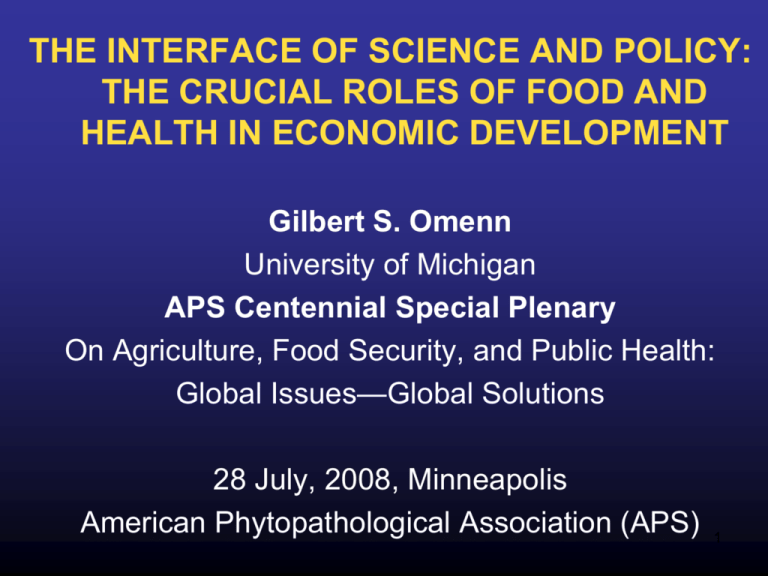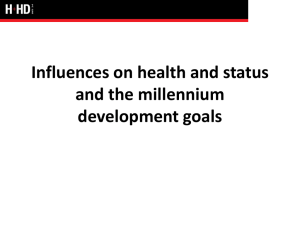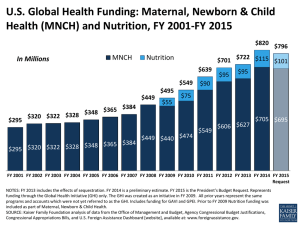THE INTERFACE OF SCIENCE AND POLICY: THE CRUCIAL
advertisement

THE INTERFACE OF SCIENCE AND POLICY: THE CRUCIAL ROLES OF FOOD AND HEALTH IN ECONOMIC DEVELOPMENT Gilbert S. Omenn University of Michigan APS Centennial Special Plenary On Agriculture, Food Security, and Public Health: Global Issues—Global Solutions 28 July, 2008, Minneapolis American Phytopathological Association (APS) 1 Disclosures • Board of Directors Amgen, Inc (medical biotechnology) Rohm & Haas Co (materials and chemicals) Occulogix (medical devices for eye diseases) • Scientific Advisory Boards Divergence Inc (nematode genomics) Population Services Intl (social marketing) Innocentive Innovation Inc (internet problem-solving) Compendia Biosciences Inc (bioinformatics) 3M Co (toxicology and epidemiology) Motorola Inc (electric and magnetic fields) 2 Outline of Talk • Societal Context for Science • Grand Challenges in Health, Nutrition, Water, and Economic Development • UN Millenium Development Goals • Gates Fdn Challenges in Global Health • Importance of sociopolitical dimensions • Need for indigenous scientific capabilities • Need for public understanding/support of scientific approaches to these challenges 3 International Science and Policy Often Dominate the AAAS Presidential Addresses 2008, David Baltimore: International Cooperation in Science and Technology 2007, John Holdren: S&T for Sustainable Well-Being (Science 319:424-434, 2008) 2006, Gil Omenn: Grand Challenges and Opportunities in Science, Technology, and Public Policy (Science 314: 1696-1704, 2006) 2002, Peter Raven: Science, Sustainability, and the Human Prospect. Science 297:9544 958, 2002. Contributors to Global Mortality, 2000 (WHO, Holdren) Cause Malnutrition (child, maternal) Excess nutrition/low activity Unsafe sex Tobacco Unsafe water War and revolution Indoor smoke (solid fuels) Alcohol M yrs life lost 200 150 80 50 50 40 35 30 5 Societal Context for Science • Literacy, science, and math education for all • Scientific research—indigenous and collaborative • Practical applications of science—priority-based • Evidence-based decision-making All depend upon the broader society---with functioning educational systems, robust economy, social justice, and effective governance and administration. And with respect for the scientific methods of observation, experimentation, and challenge of conventional views. 6 U.N. MILLENIUM DEVELOPMENT GOALS These goals for peace, security, development, human rights and fundamental freedoms (1990 to 2015) are peoplecentered, time-bound, and measurable; 191 signatories. 1. Eradicate extreme poverty (<$1/day; 1 billion people) and hunger--in 50% of the affected population 2. Achieve universal primary education for boys and girls 3. Promote gender equality and empower women 4. Reduce child mortality rate before age 5 by 67% 5. Improve maternal health--reduce mortality ratio by 75% 6. Combat HIV/AIDS, malaria and other diseases---begin to reverse incidence and spread 7. Ensure environmental sustainabiity--50% reduction in numbers without safe drinking water 8. Develop a global partnership for development 7 8 9 10 11 Subtleties of MDG-1: Poverty and Hunger UN Secretary-General: Complex concerns which must be overcome by addressing “the interconnected challenges of agriculture; healthcare; nutrition; adverse and unfair market conditions; weak infrastructure; and environmental degradation”. Five indicators are used to measure progress on MDG-1: 1.The proportion of people living in poverty (<US$1/day) 2.The poverty gap (how ‘poor are the poor’) 3.The share of national income or consumption enjoyed by those in the lowest quintile of income distribution (a measure of inequality) 4.The proportion of people undernourished (a measure of food availability in a country) 5.The prevalence of underweight preschool children (a measure of child malnutrition) [U. Gentilini & P. Webb, Tufts Univ Food Policy/Applied Nutrition Program, paper 31, 2005] 12 Mid-Course Assessment Toward Millenium Development Goals (MDGs) • Excellent progress in most of south and east Asia • Many Middle East, Latin American, northern and sub-Sahara African nations failing. • Large sub-populations with persistent extreme poverty in middle-income nations like Brazil, China, Mexico 13 Tracking Progress in Maternal, Newborn & Child Survival (MDGs 4,5) • Despite rapid progress in providing vaccinations, vitamin A supplementation coverage and insecticide-treated mosquito nets to prevent major killers such as measles and malaria, few of the 68 developing countries that account for 97 per cent of maternal and child deaths worldwide are making adequate progress to provide critical health care needed to save the lives of women, infants and children (MDGs 4,5). • Exceptions: China, Haiti, Turkmenistan, several countries in sub-Saharan Africa; in all, 16 are “on track” for MDG 4. • http://www.countdown2015mnch.org (4/16/08). 14 Reasons for Slippage (Countdown to 2015) • Family planning: The unmet need for contraceptives is high. Only one-third of women in the 68 priority countries are using a modern contraceptive method – a proven means of boosting maternal and infant survival. [PSI and Buffett Foundation expanding global efforts.] • Skilled care at birth: Only half of women and newborns benefit from a skilled birth attendant; even fewer receive care in the critical days and weeks after childbirth. • Clinical care for sick children: Only one-third of children with pneumonia – the biggest single killer of children – receive treatment. • Nutrition: Under-nutrition is the underlying cause of 3.5 million child deaths annually, and 20 per cent of maternal deaths. 15 16 Food Security • Dire needs, especially in sub-Saharan Africa— 15 million people in the Horn of Africa alone dependent on emergency supplies • Political chaos, worst in Zimbabwe • Political recovery, most dramatic in Uganda, Rwanda • Food aid in short term; food production, less wasteful distribution in longer term • Added value of local agriculture = employment • Crops at risk, like flu pandemic risk—Ug99 wheat rust (neglected since discovery in 1999) • Cooperation, governance needed: African Peer 17 Review Mechanism, AU/NEPAD & TICAD Broader Donor Programs--TICAD • Tokyo International Conference on African Development (TICAD IV, Summit 5/28-30, 2008, 15th anniversary • Convened 51 African countries, 74 regional and international organizations, private sector, civil society organizations, 34 partner countries. • Proposed by Japan and initiated in1991 at UN General Assembly which promulgated the UN new agenda for the development of Africa in the 1990s. 18 Gates Foundation Grand Challenges in Global Health Launched in 2003 to harness the power of science and technology to dramatically improve health in the world’s poorest countries. Its roots lie in the Great Neglected Diseases of Mankind Program of The Rockefeller Foundation from 30 years earlier. The initiative seeks scientific breakthroughs for preventing, treating, and curing diseases that annually kill millions of people, especially children, in developing countries. 19 Global Health GC Program Features The Gates Foundation looked for “a specific scientific or technological innovation that would remove a critical barrier to solving an important health problem in the developing world with a high likelihood of global impact and feasibility.” Based on 1500 suggestions from more than 1000 scientists from around the world, 14 Grand Challenges were identified (next slide). Awards for 43 projects, involving collaborators in 33 countries, were made in 2005. Total funding $500 million from the Foundation, in collaboration with the Foundation for the National Institutes of Health, the Wellcome Trust, and the Canadian Institutes of Health Research. The Challenge generated tremendous interest and high expectations. A global participatory process; note Innocentive problemsolving analogy (www.innocentive.com). 20 GRAND CHALLENGES IN GLOBAL INFECTIOUS DISEASES: 7 Goals, 14 Challenges, 43 Grants • Improve childhood vaccines (3) • Create new vaccines (3) • Control insects that transmit agents of disease (2) • Improve nutrition to promote health (1) • Improve drug treatment of infectious diseases (1) • Cure latent and chronic infection (2) • Measure health status accurately and economically (2) 21 Nutrition Projects in Grand Challenge 9 • Pioneer’s term “Seeds of Hope” • Cassava, banana, sorghum, sweet potato • Florence Wambugu’s African Biofortified Sorghum: multiple enhancements— --balanced amino acids (Lys, Trp, Thr, Met) --suppressed phytans, kafirin/more digestible --gene constructs to produce vitamin A (from rice) Lysine, Fe, and Zn (from maize strains) --training in U.S. companies of African scientists --close the yield gap with less fertilizer, maybe less water 22 23 24 Policy Challenges and Lessons from Africa Biofortified Sorghum Project Many candidates for nutritional and physical enhancements—must be feasible and must be desired by the community Fear about first test and first use in Africa--“show us it works first in the U.S.”, at the cost of delayed introduction and potentially irrelevant soil/weather conditions; parallel with drugs Must satisfy many stakeholders---farmers, consumers, traders, regulators, activists, researchers, companies Dr. Wambugu: “Only products will drive acceptance of new technologies.” 25 Water and Health • As described by Ray Martyn and Shiney Varghese, the quantity, quality, safety, and affordability of potable water are all at risk. • Water-related diseases dominant mortality and morbidity statistics. • Ag and public health needs are in conflict; agricultural “entitlement” devastating. • Local water purification kits effective (PSI). • Big tech/desalinization long-delayed. 26 27 S&T for Smarter Water Policies • Work with nations around the world to develop low cost ways to make polluted water potable • Develop crop strains more resistant to drought • Design improved irrigation methods including reduced losses during water transport • Improve technologies for low-water-use appliances • Use water more efficiently in industry, with maximal recycling • Improve weather and climate modeling to better understand how climate change and new weather patterns will affect rainfall and flood potentials in the US and around the world • Implement stronger policies to evaluate water impacts as part of economic development planning 28 Grand Challenges in Environmental Sciences • Biogeochemical Cycles • Biodiversity and Ecosystem Functioning • Climate Variability • Hydrologic Forecasting • Infectious Disease and the Environment • Institutions and Resource Use • Land-Use Dynamics • Reinventing the Use of Materials [National Research Council, 2001] 29 Chemistry and Chemical Engineering for Sustainability Green chemistry, replacing solvents, improving catalysts Life cycle analysis tools and models Toxicologic characterization of all chemical inputs and outputs Renewable chemical feedstocks from various biomass Renewable fuel sources More efficient chemical processing Separation, sequestration, and utilization of carbon dioxide—discussed by Dr. Field 30 Science literacy at all levels Joining Science and Policy-Making • Education, health, and governance • Capacity-building in executive, legislative, judicial, public administration, and electoral institutions, with protection of human rights • Proactive prevention of conflict and post-conflict reconstruction • A results-oriented S&T approach • Setting priorities: high maternal and under-five mortality rates, prevalence and spread of HIV/AIDS, TB, and malaria • Need health system infrastructure/workforce continuity • More nutritious crops with local production 31 On The Responsibilities and Long-Term Interest of Rich Nations Kai Lee: “Search for a life good enough to warrant our comforts”. In Compass and Gyroscope: Integrating Science and Politics for the Environment, Island Press,1993. Ismail Serageldin: “Humanity cannot survive partly rich and mostly poor”. Science 296:54, 2002. Comment by Peter Raven: “The scientific attitude can bring people together on a rational basis.” First, we must bring scientists together on hotly debated topics, as IPCC has. GEOs pending. A special opportunity for APS around global threats to the food supply. 32 Donor/Partner Policies and Attitudes • MDG 8 calls for partnerships, rather than donorrecipient relationship—key distinction • Rich nations have been very slow to step up to 0.7 percent of GDP “commitments” from UN General Assembly in 1970 for O.D.A.= Official Development Assistance • Economic stresses always seem to trump foreign assistance or environmental pledges • People needs, especially medicines for HIV/AIDS patients, trump prevention, nutrition, and environmental imperatives. 33 New Instruments for Financing Global Health Initiatives • Intl Finance Facility for Immunization: bonds • Advance Market Commitments for vaccines • Debt2Health: Debt conversion for The Global Fund to fight AIDS, TB, Malaria • Airline Solidarity Contribution, led by France since 2004 (surcharge on travelers) • Global Artemisinin-Based Combination Therapy (ACT) subsidy—to avert certain malaria resistance to monotherapy • (Product)RED: Bono/Shriver trademark, LLC— cause-related marketing 34 Data for the Next Decades: IHME Gates Foundation created an Institute for Health Metrics and Evaluation (IHME) at the University of Washington (Chris Murray, PI). New Global Burden of Diseases, Injuries, and Risk Factors Study launched in 2007 (successor to 1990 GBD study). DALY estimates due in 2010. First product: under-5 mortality rates and projections; ww.healthmetricsandevaluation.org. CJL Murray, J Frenk. The Lancet 371:1191-1199, 5 April, 2008. 35 SUMMATION Improved health for the entire population, especially those in deep poverty and/or disenfranchised subpopulations, is an imperative in every country. Improved nutrition and health are essential to learn, to contribute to economic growth and sustainability, and to make decisions that control population numbers. The UN Millenium Development Goals for 2015 are science-based and technically feasible. They were launched with broad political agreement and financial commitments in 2001. 36 At this midpoint to 2015, the overall integrated strategy faces a chasm between lofty goals and social and policy deficiencies--reflecting poor governance, corruption, paralyzing poverty, armed conflicts, growing inequalities even within prosperous countries, and inadequate global investment, both financially and intellectually. There are remarkable successes in many places. The Gates Foundation Grand Challenges in Global Health and the multiple other initiatives described by the remarkable speakers in this Plenary give us optimism. The overall challenge is scale—we must find the will, the trust, the data, the resources, and the collaborative policy instruments to achieve innovation and 37 measurable progress throughout the world.





